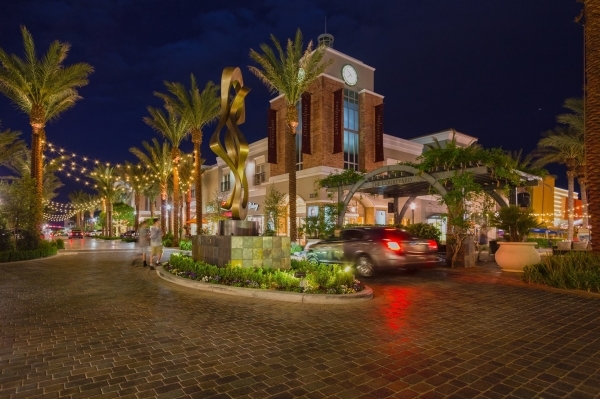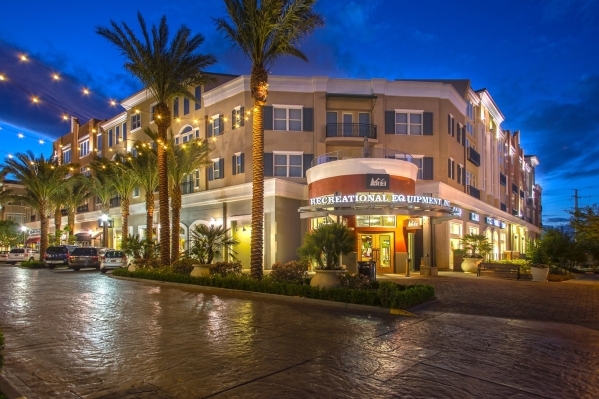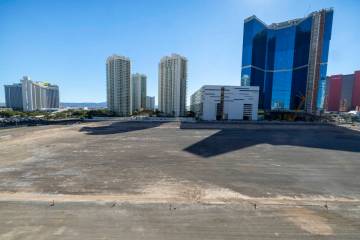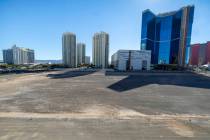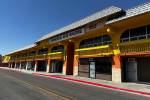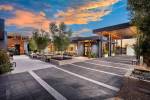After a stumble, The District finds firmer footing
It doesn't always pay to be a pioneer.
When it opened a decade ago, all eyes were on The District at Green Valley Ranch, a first-of-its-kind commercial development at the 215 Beltway and Green Valley Parkway in Henderson.
Things went well early on, with upscale tenants and consumers flocking to the American Nevada Co. project.
Still, financing and timing would bite The District in the recession, and force the center's distress sale in 2011 to partners Vestar and Rockwood Capital.
Four years later, the property's economic cycle is finally complete: In July, Vestar, a 26-year-old Phoenix company that owns and manages 24 million square feet of retail space in 10 Western states, paid $120 million for full ownership of The District.
The buyout closes the book on a tortuous odyssey for what was once Southern Nevada's groundbreaking suburban project. Similar developments have followed, but The District paved the way — and paid the price for being different.
Today, the property is effectively fully occupied and officially stabilized.
And as The District recovers, so does the rest of Southern Nevada.
Bad timing in hard times
The District proved a tidy microcosm of the economic storm that buffeted the Las Vegas Valley. Its arc involves virtually every element of the bust: A big idea built on a big debt that fell apart when consumers stopped shopping for clothes and buying homes.
The big idea? Southern Nevada's first, true live-work-play concept, an outdoor lifestyle shopping center topped with 88 high-end condominiums and 90,000 square feet of office space, laid out in a pedestrian grid to resemble city blocks. When conceived in 2001 and 2002, The District was revolutionary in the local market, predating lifestyle center Town Square on Las Vegas Boulevard by a half-decade, and mixed-use giant Downtown Summerlin by nearly 15 years.
It was a new local concept, but The District made sense, said Ted Baker, a broker with NewMarket Advisors and one of its original leasing agents.
Smaller, retail-only lifestyle centers such as Rampart Commons at Rampart and Charleston boulevards proved that upscale tenants including Williams-Sonoma and Pottery Barn could find traction in the local market, he said.
"Here (American Nevada) was, with this piece of land on a freeway in an upscale residential development, and the consensus was unanimous that this was a great location for lifestyle center," Baker said. "From a retail standpoint at the time, lifestyle retailers saw Las Vegas as a two-store market. The separation between Summerlin and Green Valley, two communities with population densities and incomes they would want, was ideal. We went to work and got a great reception."
The first phase of the 384,000-square-foot, $80 million center opened in spring 2004, nearly 95 percent leased, with new-to-market retailers such as sports retailer REI and clothing and accessories store Anthropologie.
With Phase I a success, Baker and his leasing colleagues got to work on Phase II, which would open in 2005 and favor local retailers and essential daily needs. Think grocer Whole Foods, the seed tenant for the phase.
But just as Phase II was wrapping, the economy suddenly went south.
"The market changed dramatically on all of us," Baker said.
The local economy peaked in 2006, a year after The District's completion.
Recession came knocking in 2007, and blew down the door in 2008. The taxable sales that measure consumer spending tanked by more than 25 percent through 2010. New-home sales collapsed by 90 percent from peak to trough.
The District couldn't avoid the maelstrom. Tenant sales dipped and occupancy fell. After more than a year of trying to restructure its borrowing against the property, American Nevada put its loans into strategic default in 2009. LNR Partners LLC of Florida acquired The District at a 2011 foreclosure auction on behalf of the property's lenders, who recorded deeds worth at least $76 million.
LNR Partners sold The District in 2011 for $79 million in cash to a joint venture of Phoenix-based Vestar Development and Rockwood Capital of New York.
The debt troubles, default and ownership changes "absolutely" affected The District, said Matt Bear, a vice president specializing in retail with CBRE Las Vegas.
"When you have uncertainty in any business, people are not going to make decisions, or they'll decide to move out of a situation that's unclear," he said. "And I think with all of the different owners, there was a lack of a plan on moving forward."
That began to change with Vestar and Rockwood.
Vestar declined comment for this article, but in 2011 President Rick Kuhle said it was "a great time to invest" in Las Vegas, especially in projects such as The District.
"This center has recently struggled, but we are confident and excited about stabilizing it over the coming year,'' Kuhle said at the time. "We're very bullish about these types of value-added investment opportunities and are aggressively seeking more properties like it in Las Vegas and throughout the West."
Even if new owners put The District on the path to stability, the ups and downs had taken a toll. By the time the partners bought the property, occupancy had slipped to 84 percent, Vestar said in a July 16 statement.
That's not a critically low occupancy level, Baker said, but it's a rate that makes operators nervous, because tenants often require in their leases a minimum co-tenancy, which measures how much of the shopping center is leased.
"A lot of leases for tenants in lifestyle centers will have co-tenancy provisions. When you fall low enough, maybe between 80 percent and 85 percent, you're only one decent-sized tenant away from breaching co-tenancy provisions, and people can get out of their lease or not pay their rent at all. It's kind of a white-knuckle time for developers," he said.
And The District's unusual grid had an unexpected effect on public perception. The design makes vacancies stand out, Baker said, and it didn't help to have a 5,000-square-foot, highly visible end-cap go empty when Sharper Image went bankrupt.
The District definitely needed help to right its ship.
The long road back
The Vestar-Rockwood joint venture went to work upgrading The District after the 2011 purchase.
Renovations included a new two-way street to improve access and visibility, decorative lighting above the new Main Street, upgraded outdoor furniture and seating areas, a splash pad for kids, more landscaping and — a summertime essential in the desert — more shade.
Vestar didn't disclose the cost of the improvements, though a 2014 article in Commercial Property Executive magazine pegged the investment at $3 million.
The partners have also added more than 20 new retail and office tenants since 2011, including women's clothier Charming Charlie, Elixir Beauty, restaurant Lyfe Kitchen, oil and vinegar tasting bar Oil and Vine, and, most recently, Victoria's Secret and Bath & Body Works.
At the time of its July buyout, Vestar had improved The District's vacancy to 95 percent — essentially full occupancy, Bear said.
Plus, tenant sales are up more than 20 percent, Vestar said.
"Vestar is committed to the success of The District and is proud of what we have accomplished with the property thus far," said Jeff Axtell, Vestar's executive vice president, in the company's July 16 statement announcing the buyout of Rockwood's share. "Rockwood Capital has been an exemplary capital partner for us and has realized a significant return on its investment. We look forward to working with them on future ventures."
Having one owner will make things even easier for The District, Baker said.
"It certainly makes executing on decisions faster. You have one management team versus two," he said. "And Vestar knows what they're talking about. They know how to execute on retail. It will very much be a net positive for the development to have Vestar in charge."
Vestar is experienced in retail management and turnarounds. It's in the middle of a $20 million revamp of The Village at Orange in Orange, Calif., where it has added fashion tenants and filled vacant spaces. Home Goods is taking over an empty Old Navy store, while Noodles & Co. is set to lease space abandoned by Famous Dave's BBQ. The company also built the $180 million Desert Ridge Marketplace in Phoenix, opening the open-air lifestyle center in 2001 and building consumer traffic with more than 300 annual events, including concerts and art classes.
Most importantly for The District, it's officially now a traditional property, at least financially. It no longer ranks as distressed, and its final turn of the corner is seen as a symbol that "Las Vegas no longer has a red letter 'X' on it among investors and lenders," Bear said.
Kyle Nagy, director of CommCap Advisors in Las Vegas, agreed that investors and lenders are more confident in the local market. The numbers show in business for CommCap, a mortgage banker specializing in commercial real estate.
Of all of CommCap's national lending sources, only a third were funding loans in Southern Nevada in 2009, Nagy said. Today, all of them are. What's more, CommCap closed more loans from May through August than it closed in 2008, 2009 and 2010 combined.
"Lenders and investors are here, though they're still not as aggressively pursuing loans and property here as they are in some other markets," Nagy said.
Added Bear: "It's clear the market has stabilized, and whatever the net income is of a property today, everyone is comfortable they can remain at that level. And if you're good at what you do, you can even grow your income."
As for The District's pioneering concept, the market has proven it can work, observers said. The idea has been copied with success at Town Square and Downtown Summerlin, and its nearly full occupancy reflects demand for its space.
"There was nothing fundamentally wrong with the project," Bear said. "It gives that trade area something different and unique for shopping, something that residents can call their own. And that's important, because otherwise, people would just stay home and shop on the Internet."
Contact Jennifer Robison at jrobison@reviewjournal.com. Find @_JRobison on Twitter.



